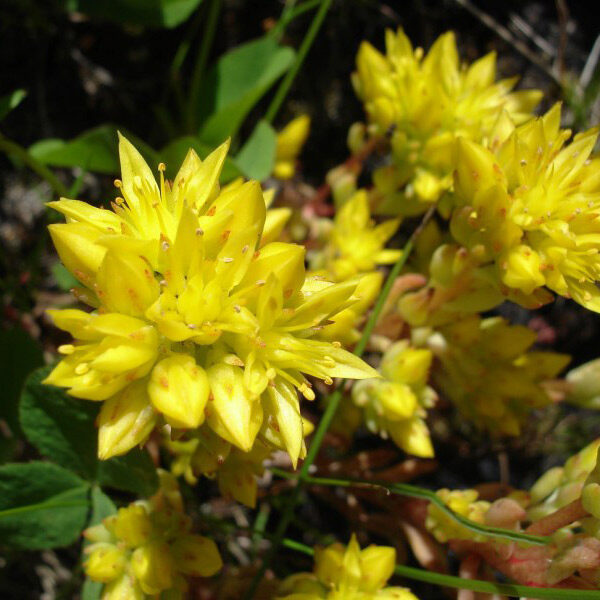Lance-leaved Stonecrop
Sedum lanceolatum Torr.

overview
Hairless, succulent perennial from a slender rhizome, stems 5-25 cm high, tufted. Leaves alternate, narrowly lance-shaped to elliptic, but rounded and fleshy in cross-section; mostly near the base (stem leaves tend to drop off before the plant flowers) and crowded on sterile shoots; sometimes covered with a white-waxy powder; often turning bronze colour in autumn. Flowers yellow, parts in fives; petals narrowly lance-shaped and 6-9 mm long, in dense flat-topped clusters. Fruits are erect follicles (Pojar and MacKinnon, 1994). Photo by Dave Polster.
family
Crassulaceae
ecological setting
Dry to moist, rocky, open sites at low to subalpine elevations (Pojar and MacKinnon, 1994).
soil texture
Coarse-textured, sandy or gravelly, free-draining soils.
nutrients
Nitrogen-poor soils.
moisture regime
Characteristic of moisture-deficient, water-shedding sites.
shade tolerance
Shade intolerant.
successional status
Climax species on extremely dry sites. Pioneer seral species on dry open sites after disturbance.
bec zone subzone status
Common on dry, exposed rock outcrops in Garry Oak ecosystems.
site rehabilitation
Possible use as a reclamation species on very dry sites.
landscaping
Showy flowers and interesting leaf colour make this a very valuable ornamental for the front of borders, rock gardens and containers (S. Bastin, pers. comm.). Combine with nodding onion, woolly sunflower, penstemons or alumroot (Pettinger and Costanzo, 2002).
first nations
Leaves edible and were eaten by some aboriginal groups, but should be consumed in moderation because some have emetic and cathartic properties and can cause headaches (Pojar and MacKinnon, 1994).
other uses
Some species of stonecrop were used as a de-worming medicine (Pojar and MacKinnon, 1994).
flowering time
June - July
fruit ripening time
July - August
seed collection time
July -August
crop intervals
Annual
collection and abstraction
Collect follicles when ripe by hand-clipping into a collection bag. Allow to dry and shake bag to release the seed. If growing sedum in containers, place pots or flats filled with soil around the containers and let seed disperse naturally onto the bare soil surfaces. Store outside for natural dormancy-breaking and spring germination (Dick, personal communication).
fruit seed dormancy treatment
Sow seeds into outdoor containers or flats in the autumn and allow dormancy to break naturally. Alternatively, cold stratify stored seed for three months before sowing in the spring (Pettinger and Costanzo, 2002).
vegetative propagation
Sedum lanceolatum is the easiest of all rockery plants to propagate. Leaves, stems or rosettes will root with little or no pre-treatment (Kurkberg, 1996).
| Method | Success Rate | Time of Collection |
|---|---|---|
| Softwood cuttings | Very high | Spring, summer, fall |
| Semi-hardwood cuttings | n/a | n/a |
| Hardwood cuttings | n/a | n/a |
| Root cuttings | n/a | n/a |
| Suckers | n/a | n/a |
| Plant division | High | Spring, summer, fall |
additional info and photos
For more information and pictures, visit the E-Flora BC website at www.eflora.bc.ca.